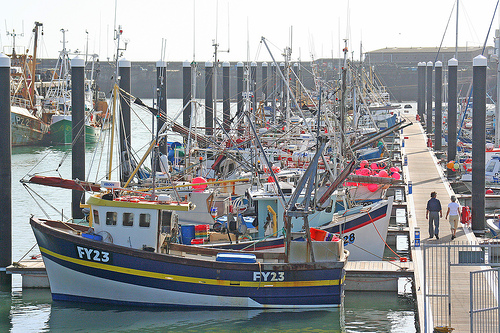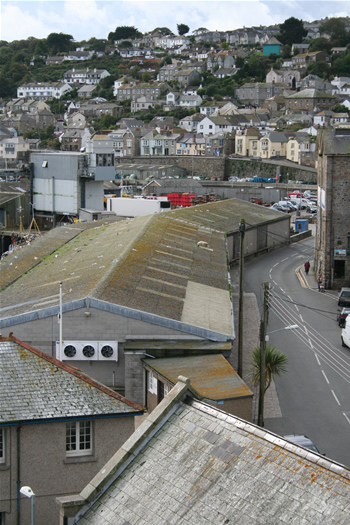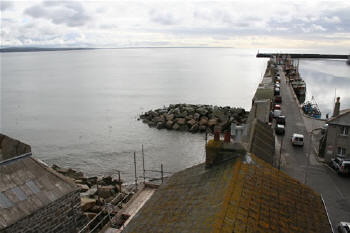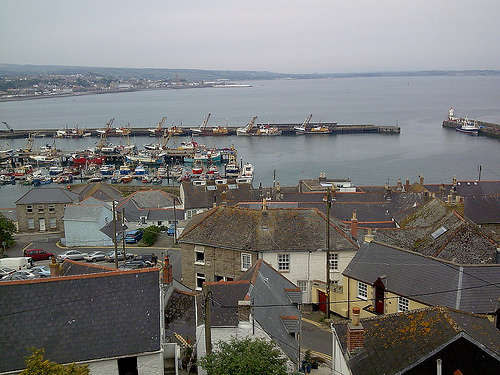|
|
| home | features | exhibitions | interviews | profiles | webprojects | gazetteer | links | archive | forum |
|
Creative Cornwall Nicolas Serota Transcription of a talk given in Newlyn after the opening of the Exchange, Summer 2007.
'I want to begin by saying that The Exchange is an astonishing example of what can be achieved by a group of people, and particularly one person, who has an absolute vision and determination. We wouldn't be here this morning if it wasn't for Liz knowles who led the project through all the vicissitudes and funding difficulties of the last 6 years, and I wanted to say its an incredible achievement, Liz. You're sitting on the back row today, but at least from the back row you'll be able to observe how we all perform not only today but over the next few years as we have to build on what it is that you have given us here in West Penwith.
Institutions are also at the vanguard of change and I work for an institution which over the past 100 years has been able to present contemporary art to the general public. Its somehow significant that whenever it's been given this opportunity it's been given a site that nobody else has had any interest in, or wanted whether it was the old Milbank prison in Pimlico or a redundant dock in Liverpool or redundant gasworks in St Ives or a redundant power station which no-one could think of any use for on Bankside! Essentially we get a chance when everybody else has given up. We're never given prime sites. Someone said to me last night walking past the Exchange how extraordinary to come across this great light on a back street as opposed to the main street, and its true - again - that Liz has fashioned something out of nothing.
The same is true when you go to Bilbao where there are 4-5000 jobs in Bilbao that would not exist but for the creation of the Guggenheim. There are 200 million euros coming into Bilbao that would be not coming into that city but for the museum being present there. Obviously the driver for creating Tate St Ives was not economic regeneration, the driver was to recognise the achievement of one, maybe two, generations of artists living and working in a particular part of Cornwall in the mid 20th century, but the impact on the town and on Cornwall was well beyond expectations. The institution was originally expected to attract 70,000 visitors and year and is now regularly attracting 250,000 a year, and indeed next week Tate St Ives will welcome its 3 millionth visitor. When we arrived, as most will recognise, the town was somewhat in decline. It had a very short Summer season, and that season has now been extended throughout the year, and that was all bought by an investment principally by Cornwall but also by others of about two and a half million at the time, with £450,000 running costs, now up to 750,000 a year. I should add that very little of those running costs comes from Cornwall. It comes from London, from the centre. There is no reason why that shouldn't be the case. As a country we have been notoriously backward in using central government money to fund regional institutions. It was only in 2001/2 with the creation of Renaissance in the Regions that central government for the first time began to put money into the regional galleries. Here at St Ives the result of that investment - 2 and a half million capital and 3 quarters on an annual basis - brings 20 or 25 million to the economy. And its those kinds of motives as well as artistic that have seen a whole group of projects be established on the south coast of England, notably the renovation of Bexhill and Turner Contemporary Margate, they all look to St Ives as the model of what can be achieved, and all see the arts as the principle generator of economic social and cultural benefit. Its astonishing given that is the case that one still has to go to the RDA in the South West and try desperately to make the case that culture is an important part of life in this part of the world. It really is quite remarkable to me that one still goes to SWRDA and asks them why they can't take an interest in culture equivalent to that taken by Yorkshire Forward or SEDA in the South East and its interesting and really one has to see it has a signal of the challenges that face everyone in this room that I believe that theres isn't anyone present from the RDA here present this morning (audience member announces themselves. Laughter). I'm pleased to see you and perhaps we can have an exchange later about this...I'm glad you're here. It is a major challenge to try and persuade the agencies that the arts have something to contribute beyond being a hobby or something that one does after you've finished work or at the weekends or whatever.
That, in a way, is a very straightforward kind of a challenge, but the real challenge of Tate St Ives as it moves into its 15th year is actually to be thinking not so much about the past, important though that is, but also about the present and the future. To do that we need to think about what it means to be a gallery at the beginning of the 21st century, and I think that means rather more than simply being a receptacle for showing works of art albeit in an imaginative way. That means about thinking not only about visitors to the gallery but also about the contribution we can make to the whole of life in this part of Cornwall. I think we need to be thinking about artists and their needs in this community. Susan Daniel McElroy did some very interesting work during her time at Tate St Ives by creating residencies that brought a number of artist from outside the county some of whom have stayed. She also provided opportunities for artists who were already within the county to move and work in a different place and different situation and eventually show their work. I think an institution like Tate St Ives needs to do this on a regular basis. It needs to work with others to provide workspace for artists which is one of the reasons why the Tate has been so strongly engaged with the Borlase Smart John Wells Trust to create studios in Porthmeor and here in Newlyn. It needs to work with others and encourage the creation of production facilities in the community. It is n't enough simply to have artists working alone in studios. They often need support of different kinds and one of the great tragedies of recent years has been the demise of not only of Hugh Stoneman himself but the whole studio complex he built up, which was packed with artists who wanted to make prints from all over the country. But sadly that whole workshop facility has been dismembered. The presses have gone to Falmouth and elsewhere and I'm sure they see good use, but actually it was the start of something really extraordinary that Hugh had created here and its now, to a large extent, gone.
This theme of collaboration is I think really crucial to the way we work in the future. We're not these isolated competitive institutions with Tate and Newlyn squabbling over which artist they will show - not that that has happened in the past - but one has to think about the whole community and there are so many artists whose work needs to be shown. We need to work with the Leach Pottery, with Newlyn and Exchange, and in a way we haven't previously, with Eden, especially as we think about the pressing issues that face us all at the moment in the way of climate change and environmental challenge. We need to work with Penlee and with Truro, with other institutions in the county, and probably above all else with the combined universities of Cornwall, or University College Falmouth, or the Arts University of Cornwall or whatever it will become over the next 5 years. Because we need to be a knowledge-based institution, we need to be a research-based institution and we need to be working very closely with others who are opening up possibilities in the field of research. If we do all this we can contribute to creating a new kind of institution. Most of the major national institutions are located in major urban conurbations. Tate is the only one that have a what used to be called an outstation but I regard as a principle part located in a rural location and we need to see Tate St Ives as a platform for developing ideas about being a gallery in a rural location. We need to re-centre Cornwall so its not seen as being at the end of the line, but so its actually seen as the centre of a new world that connects Cornwall with Brittany, with Portugal with Spain, with Ireland with Scotland, so what I would call the Phoenician trajectory that lies at the heart of the identity of what Tate St Ives and this part of Cornwall could be. It isn't about the end of something its actually a part of something else. Its a question of getting the rest of the world to recognise that the heart has moved from where you thought it was, to where it will be as we move into the 21st century. That's one of the reasons why I support the initiative being led by Cornwall County Council and probably the RBA to try and establish the notion of a cultural region, in this part of the world. It is a very very interesting idea. It does involve everyone thinking about the world in a different way, and seeing it from a different point of view which of course comes back to Declan as chair coming from Ireland...'
Other talks from the same event to follow.
|
|
|

 Over the last 100 years or more artists and some
arts institutions have been at the vanguard of economic and social change. If you
think what has happened in some urban centres: Newlyn in the 1890s or
St Ives in the 1930s, and you think about what happened in St Catherine's Dock or
Covent Garden or Soho, or Butler's Wharf in the 1960's and 70's, you can see that
artists usually perceive opportunity. But they
have often been subsequently pushed out by the economic changes that have occurred as a
result of their arrival, unless organisations like Acme have been able to
guarantee and preserve work spaces for them in the heart of the community that
they have helped to regenerate. Its tremendous to have these geese laying golden
eggs but if you're not careful you can easily destroy the economy by not making
sure that artists and other creative people can come into the area in the long
term and not only in the short term.
Over the last 100 years or more artists and some
arts institutions have been at the vanguard of economic and social change. If you
think what has happened in some urban centres: Newlyn in the 1890s or
St Ives in the 1930s, and you think about what happened in St Catherine's Dock or
Covent Garden or Soho, or Butler's Wharf in the 1960's and 70's, you can see that
artists usually perceive opportunity. But they
have often been subsequently pushed out by the economic changes that have occurred as a
result of their arrival, unless organisations like Acme have been able to
guarantee and preserve work spaces for them in the heart of the community that
they have helped to regenerate. Its tremendous to have these geese laying golden
eggs but if you're not careful you can easily destroy the economy by not making
sure that artists and other creative people can come into the area in the long
term and not only in the short term.  Tate have over the last twenty years or more we have
given very visible demonstration of the economic and social changes that can
occur if you make what are in local authority terms a very small investment. The
prime example has to be Tate Modern where we have created 3000 jobs in
Southwark, and brought probably 150million into the economy in London and all these
other statistics that have come out of reports that all of you have read.
Tate have over the last twenty years or more we have
given very visible demonstration of the economic and social changes that can
occur if you make what are in local authority terms a very small investment. The
prime example has to be Tate Modern where we have created 3000 jobs in
Southwark, and brought probably 150million into the economy in London and all these
other statistics that have come out of reports that all of you have read. 
 Of course Tate St Ives needs to be thinking about
the way it develops its exhibitions and programmes not only within the gallery
but also in the wider community and it needs to be working with others to create
opportunities for commissions for artists not just within the gallery but
beyond.
Of course Tate St Ives needs to be thinking about
the way it develops its exhibitions and programmes not only within the gallery
but also in the wider community and it needs to be working with others to create
opportunities for commissions for artists not just within the gallery but
beyond.